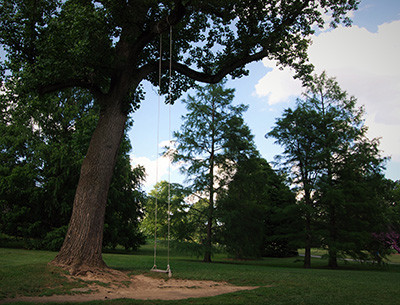
Plants of the Week: July 3

Liriodendron tulipifera
While I was walking the grounds of the Scott Arboretum on a exceptionally hot day, I began to think back to my time as a teenager running around campus on balmy summer nights. The massive tulip tree towering over the Conifer Collection was always a prime destination. With the first day of summer just recently passed, I find writing about this particular tree to be more than appropriate.
Liriodendron tulipifera, able to grow to 90 feet tall with a possible span of 50 feet, holds the largest swing I have ever personally swung on. A splendid tree for large landscapes, L. tulipifera is best grown in moist, well-drained, rich soil. L. tulipifera is a deciduous tree, indigenous to North America with its name deriving from its cupped-shaped, tulip-like flowers that bloom from May to June, depending on the region. These beautiful yellow and orange flowers go relatively unnoticed until the petals begin the drop below the tree. The four-lobed bright green leaves can grow to be eight inches across and turn stunning golden yellow in autumn. Photo Credit: R. Armstrong
Spigelia marilandica
Making my way from the swing, my next destination was the Scott Outdoor Amphitheater for some nighttime hide and seek. At the entrance of the amphitheater, nestled under some rhododendrons, are little clumps of Spigelia marilandica.
This herbaceous perennial has glossy green leaves, which highlight the trumpet-shaped, red and yellow blooms that open in June, attracting hummingbirds to the garden. Best grown in full to part shade, S. marilandica is drought tolerant, but prefers moist, rich soil. The low clumping habit of S. marilandica, commonly referred to as Indian pink, makes it a fantastic addition to wildflower gardens, native plants gardens, woodland gardens, and border fronts.
Kniphofia ‘Pineapple Popsicle’
Although I was up to some mischievous nonsense as a teenager, I always made sure to be respectful when needed. Running around and hiding in bushes was appropriate in the Crum Woods, but was not appropriate anywhere near the Cunningham House. As an adult, walking these gardens, I notice plants I never stopped to appreciate as a youngster, such as the Kniphofia ‘Pineapple Popsicle’ along the west side of the Terry Shane Teaching Garden.
This little herbaceous perennial is best grown in well-drained soil, where root rot can be a severe problem, particularly in winter. ‘Pineapple Popsicle’ is a hybrid, causing the flower to produce inviable seed. It is best to divide the rhizomes for propagation. Commonly known as red-hot poker, Kniphofia has a 1- to 2-foot yellow flower spike emerging from the center of a cluster of coarse, long, thin, leaves anywhere from June to July. The flowers bloom bottom to top changing their shape from wider on the bottom at the beginning of their bloom to wider on the top at the end. The blooms last two to three weeks and are best pruned back immediately after they are finished blooming. Photo Credit: R. Armstrong







No Comments